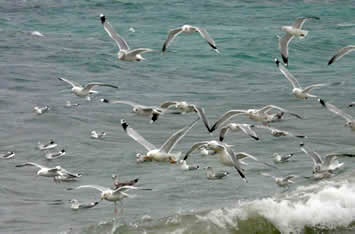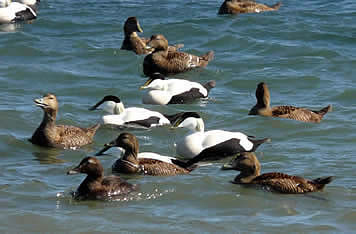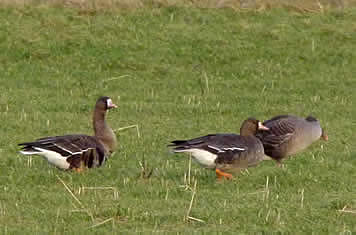Seasonal Highlights
North Ronaldsay’s Birds a month-by-month guide
Introduction
For anyone with an interest in birds, whether a casual enjoyment of observing wild creatures in their natural surroundings or a compulsive fanaticism for rare vagrants, North Ronaldsay offers as spectacularly varied a birdwatching experience as can be found anywhere in the country: a diverse range of wetland habitats supports breeding and wintering populations of myriad wildfowl and wader species; the coastline, combining rugged, rocky outcrops and beautiful sandy beaches, provides nesting sites for busy colonies of seabirds and important feeding areas for large flocks of migrating arctic waders; and the island is perfectly situated to observe spectacular numbers of passage seabirds streaming past offshore. And then, of course, there is the virtually limitless array and quantity of migrant landbirds that can be seen during the spring and autumn migration periods: the dramatic falls of migrants and prolific rarity finds for which North Ronaldsay is perhaps most famed.
North Ronaldsay Bird Observatory is the perfect base from which to discover these, and other, avian delights at any time of year. The expert ornithological staff are on hand to help visiting birdwatchers get the most out of their stay, and visitors are always welcome to accompany them in carrying out bird ringing and to contribute their own sightings to the daily bird log.
There is something to see at any time of year, but this month-by-month breakdown of the main seasonal highlights should help you to decide when to visit and give you an indication of what to expect.
January and February
Although the North Ronaldsay midwinter can be a bleak and windy experience, calm and sunny spells do occur regularly and the island supports a wonderful selection of wildfowl during the coldest months of the year. Hundreds of Eiders, along with small numbers of Long-tailed Ducks, Red-breasted Mergansers and Goldeneyes – all in smart breeding plumage – gather in the sheltered bays; while the lochs and wetlands hold Mallards, Teals and Wigeons by the hundreds, and dozens of Shovelers, Tufted Ducks, Pintails and Gadwalls. An ever-increasing winter population of Greylag Geese, containing more than a thousand birds in recent years, spreads into most areas of the island, and often contains a few Pink-footed Geese and the occasional White-fronted or Bean Goose. A flock of Icelandic Whooper Swans usually spends the winter at the north of the island.
There is always a good variety of waders around the coastline, and gulls can also be present in large numbers, particularly Common, Herring and Great Black-backed Gulls. Both Glaucous and Iceland Gulls are regularly present and are always worth looking for, and Black-headed Gulls start returning to their colonies in late February. Landbirds can be thin on the ground, but good numbers of Twites and Snow Buntings can be seen, and Merlins and Hen Harriers are always around.
For the rarity-minded birder, the ducks and geese provide plenty of potential for finding something, the gulls are not without interest, and surprises are not unknown: Snowy Owl, Temminck’s Stint and Arctic Redpoll have turned up at this time of year.
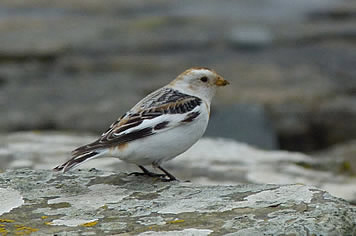
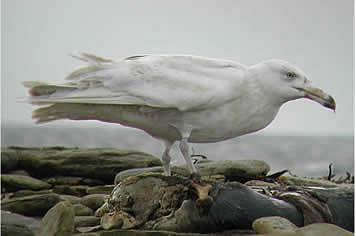
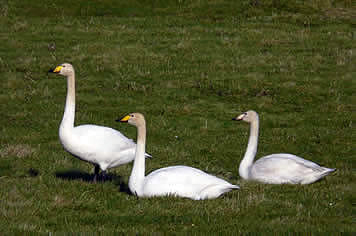
March
The winter species are all still present into March, including the full range of wildfowl, waders and gulls. The first Sandwich Terns should be returning, and very large gatherings of Oystercatchers occur at this time. The beginnings of spring passerine migration become evident as the first Meadow Pipits and Pied Wagtails arrive. Large numbers of Skylarks can pass through, and small numbers of other migrants such as Robins, finches, thrushes and Dunnocks start to appear. By the end of the month, the first Wheatears and Chiffchaffs might have turned up. Stonechats and Hawfinches are scarce, but this is probably the best time of year to look for them.
Although Bittern, Kumliens Gull and Gyr Falcon have been recorded early in the month, rarities become a more likely possibility as March progresses. The end of the month is a good time for White-billed Diver and White-tailed Eagle and the flocks of ducks and geese often contain the less common species.
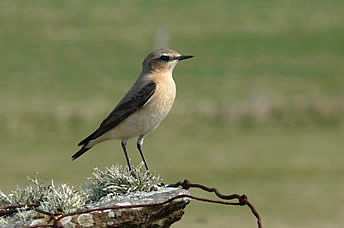
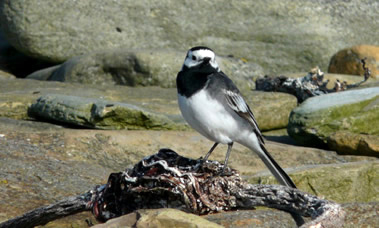
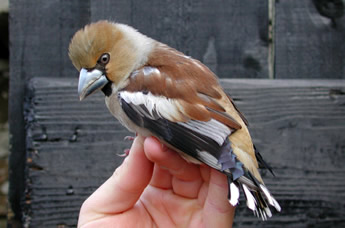
April
The gears of migration should have begun turning properly by this time; the numbers and variety of migrants should be increasing and there can be plenty to see. Finches, thrushes and Wheatears continue to pass through all month, and the first White Wagtails, Willow Warblers and hirundines appear. The variety increases further in the second half of April, and most of the standard summer migrants, including Tree Pipits, Whinchats, Redstarts, Pied and Spotted Flycatchers and many types of warbler should have been recorded by the month’s end. Sizeable falls of some species are possible, including large arrivals of Wheatears and warblers. Corvid passage is usually much in evidence, and the arable fields can contain flocks of summer-plumaged Lapland Buntings with the Skylarks.
The variety of waders remains high and a wide range of wildfowl remain, although the numbers of the latter are beginning to dwindle. Breeding species including the Black Guillemots and Arctic Terns will be back on their territories; the various nesting wildfowl, including Little Grebes, Gadwalls, Wigeons and Shovelers will be tucked away in the increasingly impenetrable vegetation; and Snipe, Redshanks, Curlews, Lapwings and other waders will be getting into their breeding seasons. There are usually a few smart Great Northern Divers around the coast, and occasionally large congregations are seen.
This is a good time of year to see a fantastically diverse number of species, and minor rarities can almost be expected. White-billed Diver and White-tailed Eagle are just about annual visitors in April; King Eiders are a real possibility offshore and Subalpine Warblers, Red-throated Pipits, Short-toed Larks and various other rare passerines are often recorded. Rarer raptors in April have included Rough-legged Buzzards, Goshawks and Hobbies, and there have been several records of Snowy Owl. Surprises should come as no surprise at this time: most things are possible. There are only two records of Magpie on North Ronaldsay – both in April.
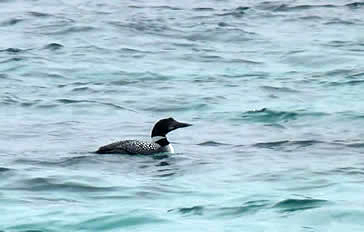
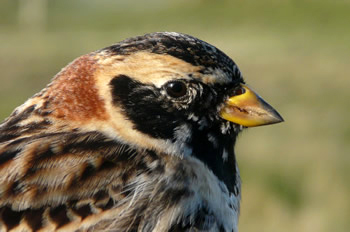
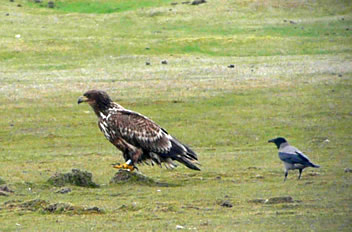
May
Spring migration reaches its peak, and this can be a truly fantastic time of year. The full range of expected summer migrants can be seen, impressive numbers of waders build up on the golf course and Tor Ness, and all the nesting species will be well into their breeding season.
This is probably the best month of the year for potential species diversity. Passerine Migration reaches its zenith and is often the main focus. All regular summer migrants will be passing through, sometimes in impressive numbers, and scarcer spring species such as Bluethroats, Red-backed Shrikes, Common Rosefinches and Icterine Warblers can be expected towards the end of the month. Given suitable weather conditions, some of the most incredible falls of migrants ever recorded on North Ronaldsay have occurred in May, including triple-figure counts of Whinchats, Redstarts, Wheatears (up to more than 800), Willow Warblers and Spotted Flycatchers.
The wader flocks are spectacular, with hundreds of summer-plumaged Turnstones, Sanderlings, Ringed Plovers and Dunlins gathered on areas of short grass and heath. Less common species passing through usually include Little Stints, Curlew Sandpipers, Wood and Green Sandpipers and Greenshanks, and the first week of the month usually produces some Dotterels.
Many rarities – too many to list here – have been found in May; it can be one of the most exciting times on the calendar. Ortolan and Rustic Buntings, Thrush Nightingale and Red-footed Falcon are examples of species that have occurred numerous times, while past May mega rarities have included Calandra Lark, Orkney’s only Montagu’s Harrier, Little Bustard, White-throated Sparrow, Sardinian Warbler and Collared Flycatcher.
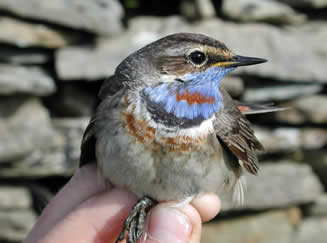

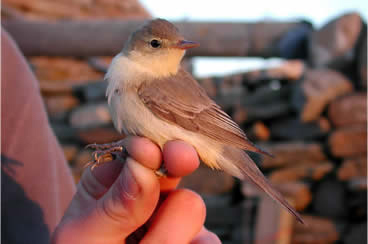
June
Early June continues where May left off: spring migration is petering out, but it is often the scarcer migrants that continue to appear. The Bluethroats, Red-backed Shrikes, Icterine Warblers and Rosefinches still arrive, sometimes in impressive numbers, and it is the best time for Marsh Warblers. Most of the migrant waders will have departed to their arctic breeding grounds, but the breeding species will be busily defending their eggs and chicks from the predatory attentions of skuas, gulls, crows and even sheep.
The first half of the month typically produces only low numbers of migrants, but they often include the most surprising rarities. Such disparate species as Pine Bunting, Scops Owl, Roller, Snowy Owl, Booted Eagle, Tawny Pipit and Pallas’s Rosefinch have chosen June as the time to make their appearance here.
Later in the month, migration finally grinds to a halt: a brief hiatus before the returning waders start to appear. Calm weather in June is always good for scanning the sea for Orcas, which often visit the island’s seal colonies at this time of year. Risso’s Dolphins and Basking Sharks are also seen regularly.
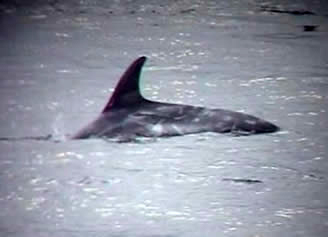
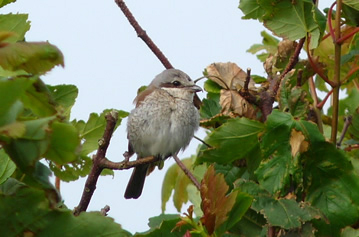
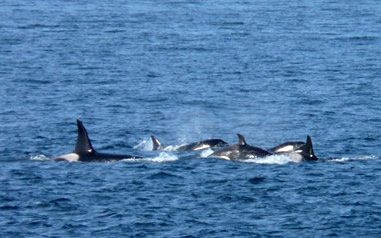
July
July is usually a quiet time of year, but waders soon start reappearing around the coast. Purple Sandpipers, Dunlins and Whimbrels are present, and Golden Plovers build up into flocks of several hundred. The observatory staff begin nocturnal ringing of Storm Petrels, often catching hundreds of birds and sometimes a few Leach’s Petrels too. Red-necked Phalaropes regularly occur on the inland lochs, and rare waders are always a possibility. The Golden Plover flock, in particular, is worth a close look: American and Pacific Golden Plovers are found with remarkable frequency.
This is always a good time to keep an eye on the seas that surround the island. Orcas and other cetaceans remain a regular sight throughout the summer, and the later part of the month sees the beginning of autumn seabird passage.

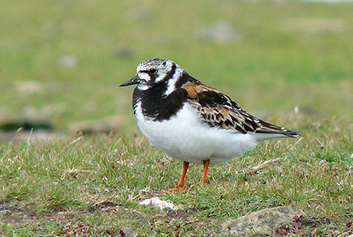
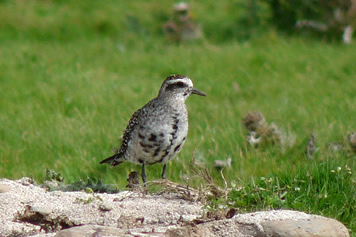
August
This can be a good, varied month for birding on North Ronaldsay: big flocks of waders gather around the coast, huge numbers of seabirds often pass by the north-east corner at close range, and the autumn passerine migration gets underway.
The usual waders include Ringed Plovers, Knots, Sanderlings, Dunlins, Turnstones and Golden Plovers, with small numbers of Ruffs, Little Stints, Curlew Sandpipers, Greenshanks and godwits. Pectoral Sandpipers, both ‘lesser’ Golden Plovers and other rare species are well worth looking for.
Seawatching here can be spectacular when seabirds surge en masse from the North Sea into the Atlantic, Fulmars, shearwaters, skuas, auks, gulls and terns passing in front of the hide in an endlessly mesmeric westbound procession. Hundreds of Sooty Shearwaters are seen on some days, occasional substantial movements of Great Shearwaters have also occurred in recent years, and Cory’s and Balearic Shearwaters occasionally join the more regular species.
Warblers, pipits and Wheatears start arriving on their southward migrations, and a wide variety of other species can usually be found. Cuckoos, Whinchats and Wood Warblers often appear in the second half of the month; Wrynecks and Rosefinches are regular; and this is the time of year for Barred Warblers. A rarity or two can usually be expected among the commoner species: Black-headed Bunting, Melodious Warbler and Greenish Warbler have all appeared several times in August, while mega rarities including Yellow Warbler, Spanish Sparrow and Blue Rock Thrush have occurred on occasion.
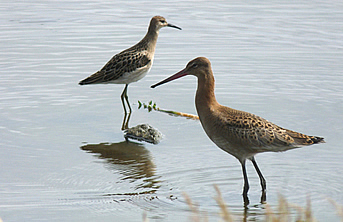
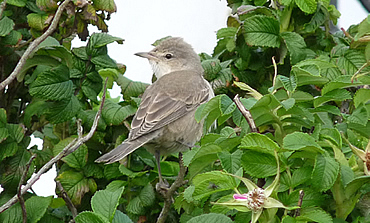
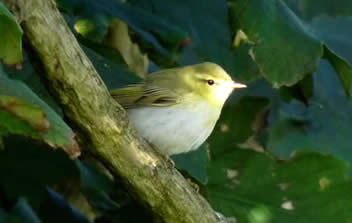
September
September is often considered the most exciting month of the year – and not without good reason: this is a time, at the peak of autumn migration, when almost anything can turn up. A wide range of passerines, including all the common species and regular scarcities, can be expected; raptors of various kinds and most families of near-passerines are well-represented; waders continue to pass through, often including rarities; and seabird passage reaches its annual climax.
Virtually the whole gamut of regular warblers, chats and flycatchers will pass through, with finches and thrushes increasing towards the month’s end. Species that are normally considered scarcities in Britain occur with impressive reliability here. There can be few sites as good for seeing such birds as Wryneck, Short-toed Lark, Bluethroat, Icterine Warbler, Yellow-browed Warbler, Red-breasted Flycatcher, Common Rosefinch, Ortolan Bunting and Little Bunting; and September is usually the best time of year for them.
This is probably the best month for rare birds too: there is something to get excited about every year, and the list of species seen here in September is extraordinary. There are numerous records of Great Snipe, Citrine Wagtail, Blyth’s Reed Warbler, Arctic Warbler and Yellow-breasted Buntings, to name just a few of the more regularly occurring rarities. Sykes’s Warbler, Cretzschmar’s Bunting, Red-flanked Bluetail, Pechora Pipit and Bonelli’s Warbler are some of the highlights from recent years. North Ronaldsay, in late September, must have some of the best rarity-finding potential in the country.
Numbers and variety of waders is high and, again, includes rarities with astonishing regularity. Buff-breasted Sandpiper, Pectoral Sandpiper, American and Pacific Golden Plovers and White-rumped Sandpiper seem to be the island’s specialities, but just about anything is possible.
Seawatching is as good as in August, if not better, and involves a similar selection of species. The only problem is that the right winds for seabird passage past North Ronaldsay also happen to be the right winds for delivering the biggest falls of landbirds: birders are left spoilt for choice, such an embarrasment of avian riches is there to choose from.
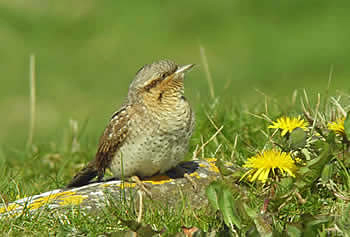
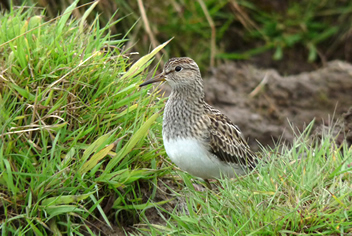
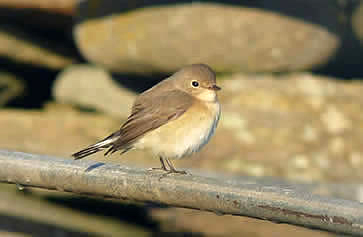
October
Almost as good as September, October birding here can be a thrilling experience. The species composition changes as the autumn progresses: thrushes and finches become increasingly numerous as the month progresses, and huge falls of thrushes are always possible in the right conditions. Typical October birds include Woodcock, Jacksnipe, Long-eared Owl and Great Grey Shrike, with Little Auk, Waxwing, redpolls of various flavours, Northern Bullfinches, Lapland Buntings and Snow Buntings arriving by the end of the month. Wildfowl numbers reach very high totals as the winter period draws closer, and Whooper Swans, geese and a wide range of ducks can be expected.
Such species as Short-toed Lark, Richard’s Pipit, Pallas’s Warbler, Arctic Redpoll and Little Bunting are a regular feature in October, along with many other scarcities. Rarities are as regular and varied as in September, particularly early in the month, and have included some of the island’s most exciting finds: Siberian Blue Robin, Rufous-tailed Robin, White’s Thrush, Siberian Thrush and Buff-bellied Pipit are among the long list of headliners from previous years.
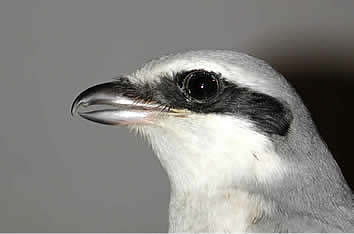

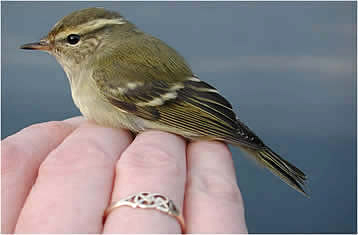
November
As the autumn gradually winds to a close, the late October species can still be expected for a while. The full complement of winter species are back in numbers, which means that the main interest soon returns to wildfowl and gulls. November is certainly not without rarity interest though: the last of autumn’s migrants often include oddities and unexpected species. Arctic Redpolls sometimes occur well into the month, and unpredictable late rarities have included Isabelline Shrike, Black-bellied Dipper, Siberian Stonechat, Olive-backed Pipit, Hume’s Warbler and Stone Curlew.
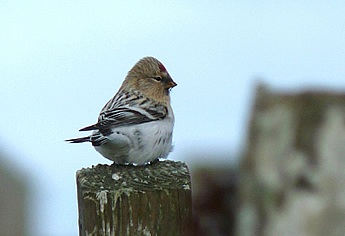
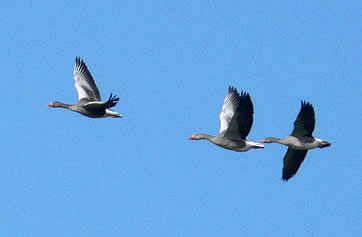
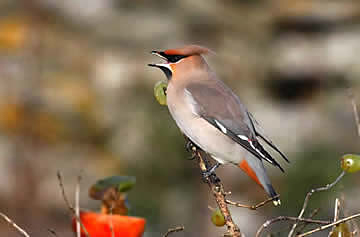
December
Shelducks return, but December has little else in terms of migration. As in January, a superb assortment of wildfowl inhabits the lochs and bays, and there are usually good numbers of gulls. The selection of landbirds is as limited as it is at the start of the year, but there is often a Hen Harrier roost at Hooking Loch which has involved up to eight birds in recent years. It is a very quiet time for scarcities, although white-winged gulls and some of the less common ducks and geese are likely to be found with a little effort.
